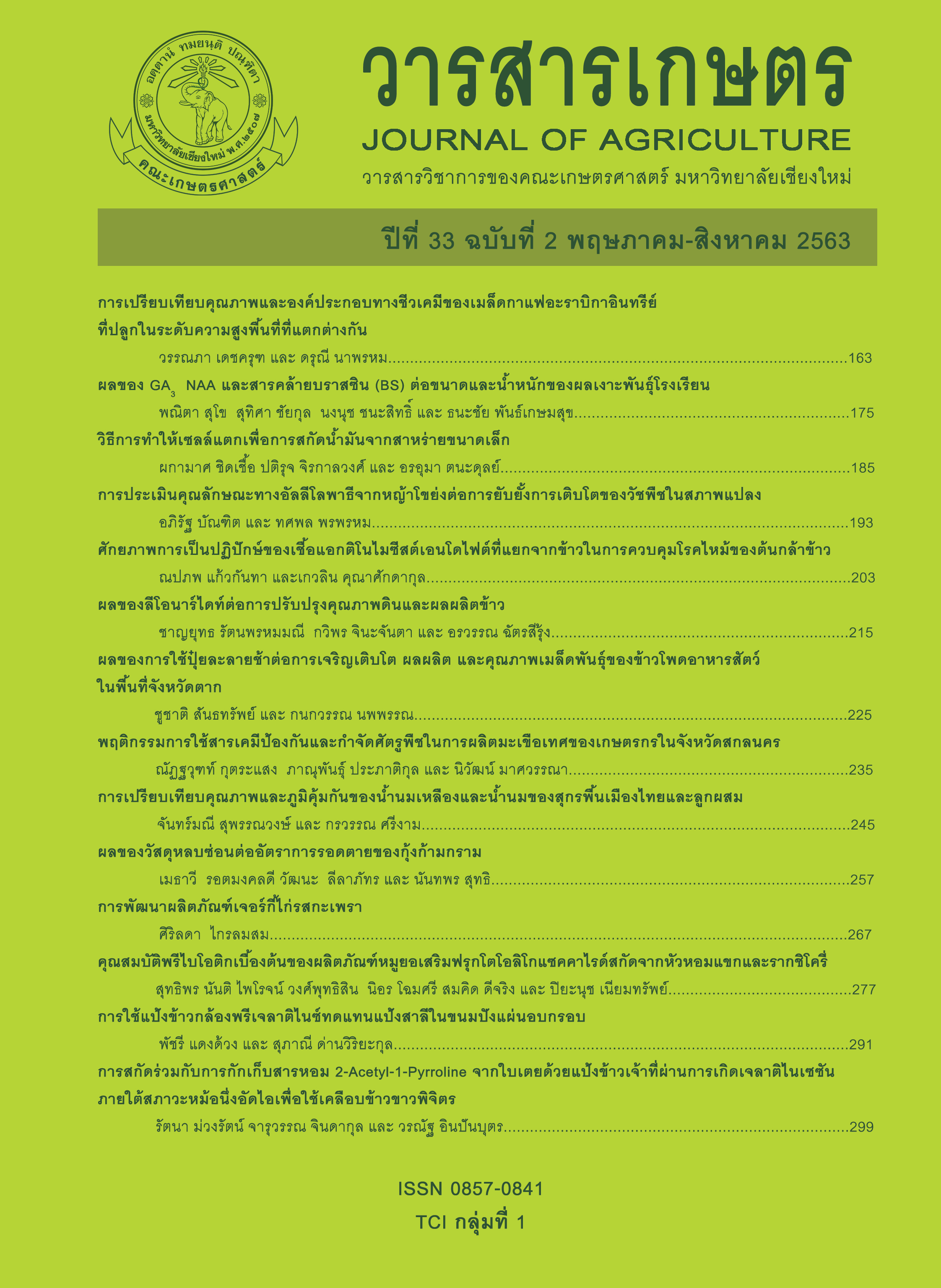ผลของลีโอนาร์ไดท์ต่อการปรับปรุงคุณภาพดินและผลผลิตข้าว
Main Article Content
บทคัดย่อ
ลีโอนาร์ไดท์เป็นวัสดุธรรมชาติที่อุดมด้วยฮิวมัสจึงมีศักยภาพสูงในการนำมาใช้ทางการเกษตร อย่างไรก็ตามข้อมูลเกี่ยวกับการใช้ ลีโอนาร์ไดท์ในข้าวนาดำมีน้อยมาก จึงได้ทำการทดลองในกระถางเพื่อวัดผลของลีโอนาร์ไดท์ต่อคุณภาพของดินและผลผลิตของข้าว พันธุ์ขาวดอกมะลิ 105 โดยใช้ปุ๋ยเคมีและปุ๋ยหมักในการเปรียบเทียบผลการทดลองพบว่า โดยเฉลี่ยแล้วการใส่ปุ๋ยหมักเพียงอย่างเดียวหรือใส่ร่วมกับ ลีโอนาร์ไดท์สามารถเพิ่มระดับ อินทรียวัตถุ ไนโตรเจน ฟอสฟอรัส และ โพแทสเซียม ได้ประมาณสองเท่าเมื่อเปรียบเทียบกับกรรมวิธีควบคุม การใช้ลีโอนาร์ไดท์ที่ปรับปรุงร่วมกับปุ๋ยหมักในกรรมวิธีที่ 8 และ 9 (ลีโอนาร์ไดท์ปรับปรุง + ปุ๋ยหมัก (1:1) และ ลีโอนาร์ไดท์ปรับปรุง + ปุ๋ยหมัก (3:1), ตามลำดับ) ให้ค่า จำนวนกอ (30.3 และ 32.0 กอ/ต้น, ตามลำดับ), จำนวนรวง (19.33 และ 18.67 รวง/ต้น, ตามลำดับ) และผลผลิตเมล็ด (50.58 และ 50.29, กรัม/ต้น, ตามลำดับ) สูงกว่ากรรมวิธีควบคุมอย่างมีนัยสำคัญทางสถิติ ค่าที่เพิ่มสูงขึ้นทั้งหมดนี้ไม่แตกต่างอย่างมีนัยสำคัญจากการใช้ปุ๋ยเคมี ผลการทดลองนี้แสดงให้เห็นว่าการใช้ลีโอนาร์ไดท์ร่วมกับปุ๋ยหมักให้ผลดีกว่าการใช้ลีโอนาร์ไดท์ หรือปุ๋ยหมักเพียงอย่างเดียว ดังนั้นจึงสรุปได้ว่าการผสมดินด้วยลีโอนาร์ไดท์ร่วมกับปุ๋ยหมักสามารถใช้เป็นทางเลือกทดแทนปุ๋ยเคมีเพื่อให้ผลผลิตข้าวที่สูงได้
Article Details
เอกสารอ้างอิง
Arancon, N.Q., S. Lee, C.A. Edwards and R. Atiyeh. 2002. Effects of humic acids derived from cattle, food and paper-waste vermicomposts on growth of greenhouse plants. Pedobiology 47: 741-744.
Bama, K. S. 2009. Foliar application of humic acid for rice yield and nutrition. Journal of Ecology 25(3): 241-244.
Chen, Y. and T. Aviad. 1990. Effects of humic substances on plant growth. pp. 161-186. In: P. MacCarthy, C.E. Clapp, R.L. Malcolm and P.R. Bloom (eds.). Humic Substances in Soil and Crop Sciences: Selected Readings. ASA and SSSA, Madison.
Department of Agriculture. 2005. Fertilizer analysis. Section of fertilizer analysis. Division of Agricultural Chemistry, Department of Agriculture, Bangkok. 52 p.
El-Razek, E.A., A.S.E. Abd-Allah and M.M.S. Saleh. 2012. Yield and fruit quality of Florida Prince peach trees as affected by foliar and soil applications of humic acid. Journal of Applied Sciences Research 8(12): 5724-5729.
Fong, S.S., L. Seng and H.B. Mat. 2007. Reuse of nitric acid in the oxidative pretreatment step for preparation of humic acids from low rank coal of Mukah, Sarawak. Journal of the Brazilian Chemical Society 18: 41-46.
Gravois, K.A. and R.S. Helms. 1992. Path analysis of rice yield and yield components as affected by seeding rate. Agronomy Journal 84: 1-4.
Hussain, N.G. Hassan, A. Ghafoor and G. Sarwar. 1998. Biomelioration of sandy clay loam saline-sodic soil. pp. 293-300. In: Proceedings of 6th Intl. Micro Irrigation Cong. March 8-10, 1998, Florida, USA.
Ihsanullah, D. and A.A. Bakhashwain. 2013. Effect of humic acid on growth and quality of maize fodder production. Pakistan Journal of Botany 45: 21-25.
Inthajak, J. 2012. Use of leonardite for improving compost quality and kale yield. M.S. Thesis, Chiang Mai University, Chiang Mai. 89 p.
Islam, A. and W. Islam. 1973. Chemistry of submerged soils and growth and yield of rice. Plant and Soil 39(3): 555-565.
Mohammadipour, E., A. Golchin, J. Mohammadi, N. Negahdar and M. Zarchini. 2012. Improvement fresh weight and aerial part yield of marigold (Calendula officinalis L.) by humic acid. Annals of Biological Research 3(11): 5178-5180.
Nguyen, B.V., D.C. Olk and K.G. Cassman. 2004. Nitrogen mineralization from humic acid fractions in rice soils depends on degree of humification. Soil Science Society of America Journal 68: 1278–1284.
Office of Agricultural Research and Development Region 1. 2016. Analysis of soil water fertilizer plants. (Online). Available: http://www.oard1.doa.go.th/index.php?option=com_content&view=article&id=48 &Itemid=12 (January 21, 2017).
Olayinka, A. and A. Adebayo. 1985. The effects of methods of application of saw dust on plant growth nutrients uptake and soil chemical properties. Plant and Soil 85: 47-56.
Pettit, R.E. 2004. Organic matter, humus, humate, humic acid, fulvic acid and humin: Their importance in soil fertility and plant health. (Online). Available: http://www.humate.info/ mainpage.htm (November 19. 2016).
Ratanaprommanee, C. and A. Shutsrirung. 2014. Chemical properties and potential use in agriculture of leonardite from different sources in Thailand. pp. 1236-1246. In: Proceedings of the 5th National and International Hatyai Conference. May 16, 2014. Hatyai University, Hat Yai, Songkhla.
Saha R., M. A. U. Saieed, M. A. K. Chowdhury and M. A. H. Chowdhury. 2014. Influence of humic acid and poultry manure on nutrient content and their uptake by T. aman rice. Journal of the Bangladesh Agricultural University 12(1): 19-24.
Sahrawat K.L. 2005. Fertility and organic matter in submerged rice soils. Current Science 88 (5): 735-739.
Shutsrirung A., C. Ratanaprommanee, K. Chinachanta, 2016. Chemical and biological properties of leonardite and application for growth enhancement of rice. Final Report. Pumpkin Tools Corporation Co., Ltd., Bangkok. 181 p.
Singh, R.D. and D.V. Yadav. 1986. Evaluation of low grade rock phosphate composted with some agricultural wastes for use in a crop rotation. Agricultural Wastes 18(1): 73-79.
Sivakumar, K., L. Devarajan, K. Dhanasekaran, D. Venkatakrishnan and U. Surendran. 2007. Effect of humic acid on the yield and nutrient uptake of rice. International Journal on Rice 44(3): 277-279.
Somchan, N. and A. Shutsrirung. 2014. Leonardite quality improvement for soil amendment. KMUTT Research and Development Journal 37(1): 33-43.
Steel R. G. D., J. H. Torrie and D. A. Dickey. 1997. Principles and Procedures of Statistics. A biometrical Approach. McGraw-Hill, New York.
Wattanaphayapkul, W. 2014. Effects of wood vinegar and manure on growth, yield and seed quality of Hom Mali rice. Journal of Agriculture 31(3): 269-279.
Vaughan, D. and D.J. Linehan. 1976. The growth of wheat plants in humic acid solutions under axenic conditions. Plant and Soil 44: 445-499.


